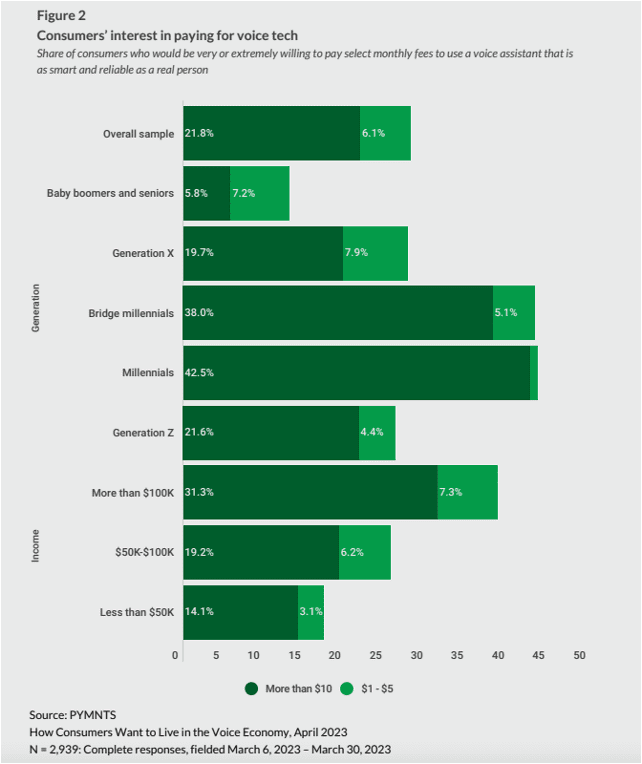
Speaking of generative AI — as everyone seems to be doing now — voice applications of this powerful technology are already transforming business, and consumer demand for more options in voice commerce is shaping the agendas of developers, brands and merchants.
In a week of revelations, both Google and Microsoft talked up the ways they’re respectively developing and rolling out generative artificial intelligence (AI) tools across the enterprise as new data measures the consumer appetite for voice interactions and the commerce experiences it makes possible.
As PYMNTS Karen Webster wrote on Monday (April 24), “Artificial intelligence will make voice interactions smart, personalized, adaptive, and engaging. As in truly engaging — conversational in every sense of the word. Not just reactive to a wake word and a series of prompts, but proactive and intuitive, anticipating actions based on history and context and anticipating what consumers might want to do next, just like an effective, smart, capable human assistant would do.”
On its fiscal Q3 earnings call Tuesday (April 25), Microsoft Chairman and CEO Satya Nadella supplied details on the computing giant’s progress, driven by its sweeping agreement with ChatGPT creator OpenAI, and noting that for its Azure OpenAI Service “From Coursera and Grammarly, to Mercedes-Benz and Shell, we now have more than 2,500 Azure OpenAI Service customers, up 10X quarter-over-quarter.”
“Just last week, Epic Systems shared that it was using Azure OpenAI Service to integrate the next generation of AI with its industry-leading EHR software. And we’re pleased to see brands like Shopify and Snap use the API to integrate OpenAI’s models,” Nadella added.
That same day on the Alphabet Q1 2023 earnings call, CEO Sundar Pichai said, “Our new generative AI features are making content creation and collaboration even easier for customers like Standard Industries and Lyft. This builds on our popular AI Bard Workspace tools, Smart Canvas, and Translation Hub used by more than 9 million paying customers.”
Pichai added, “New advances in our data cloud enable Ulta Beauty to scale new digital and omnichannel experiences while focusing on customer loyalty; Shopify to bring better search results and personalization using AI; and Mercedes Benz to bring new products to market more quickly.”

That’s all tapping into growing demand from consumers who are using voice commands in their everyday lives and see the opportunity to use it in more ways to improve the quality, convenience, and security of their digital interactions.
In the PYMNTS study “How Consumers Want to Live In the Voice Economy,” based on a survey of nearly 2,940 U.S. consumers, we found that the momentum behind increasingly “smart” Generative AI use cases has captured imaginations, and is translating to dollars, from paying for these features to using them to pay.
The study finds that 28% of Americans “are very or extremely willing to pay a monthly fee for a reliable and smart voice assistant. Among millennials, 43% are very or extremely willing to pay more than $10 a month, compared to just 5.8% of baby boomers and seniors,” with 31% of high-income consumers very or extremely willing to pay more than $10 a month.
When looking at current uses of voice AI in everyday connected living, most consumers are experiencing the benefits of voice through devices from smartphones to an assortment of smart home assistants.

That’s largely a matter of where voice interactions are available now, and a reflection of the kinds of activities consumers feel comfortable handling with voice assistants at their current state of development.
The new research finds that today, “consumers are more familiar with using voice for simpler and low-risk tasks such as playing music, at 38%, setting alarms, at 35%, and asking for directions, at 36%. Consumers are less comfortable with riskier, if not necessarily more complex tasks, where they may be exposed to particularly damaging data errors and security breaches, such as opening a bank account, at 11%, or scheduling a doctor’s appointment, at 13%.”